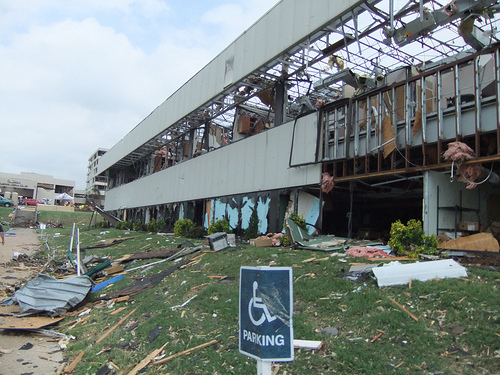
May 24, 2011 - St. John’s Regional Medical Center was severely damaged by the F-5 tornado that struck Joplin, Mo. (Photo courtesy of Mercy Health)
In May 2011, as tornado sirens sounded, hospital workers at St. John's Regional Medical Center rushed to pull 183 patients to safety as one of the largest tornadoes on record bared down on their southwestern Missouri city. Breaking glass and the roar of the powerful storm deafened the dark hospital as power was lost.
Dennis Manley, the hospital's director of quality and risk management, played a critical role as the hospital's incident commander following the deadly tornado. Guiding his hospital through a chaotic disaster was challenging but not completely unfamiliar territory thanks to training he received two years prior at the Center for Domestic Preparedness (CDP) in Anniston, Ala.
He attended the CDP's Healthcare Leadership for All-Hazards Incidents training in 2009, followed by Hospital Emergency Response Training for Mass-Casualty Incidents later that year. The course places emergency response providers in a realistic mass-casualty training scenario – a situation no one hopes to face, but Mr. Manley was faced with a similar situation as the tornado was bearing down on Joplin.

May 25, 2011 – Damage to the front entrance of the St. John’s Regional Medical Center in Joplin, Mo. after a deadly F-5 struck the town. (Photo courtesy of Mercy Health)
The CDP had a chance to catch up with Mr. Manley after the tornado, and he stressed the benefits of the CDP’s hands-on training and the advantage of training in an actual hospital at the CDP’s Noble Training Facility. He also stressed the fact that the training not only enhanced his ability to respond to a mass casualty incident, but also provided an example of the many emergency roles his staff would take on because of the tornado.
Mr. Manley also commented:
The CDP training is about as close as you can get to the real thing. I wanted realistic training and the CDP delivered. There is no substitute to real-life experience, but the CDP training mimicked it very closely.
By training in a hospital, the experience is more life-like and real. You feel like you are actually participating in a disaster, not just pretending. That makes it easier to apply what you have learned to the real thing. The CDP training helped me fulfill my role with more confidence.
While the positive feedback from past trainees is great, I’d really like to encourage emergency responders to come to the CDP and check it out for themselves. It’s National Preparedness Month, so why not make a point to schedule training to ensure you and your staff have the skills needed for the next disaster. Whether you’re an experienced professional or a freshly minted emergency responder, having hands-on training before an emergency can provide positive outcomes if disaster strikes.
And if you’re looking for some more information, here are some other blog posts about CDP training:
- In Photos: Training for a Mass Casualty Event
- My Story of First Responder Training (my perspective after going through a CDP course)
- Mayors & First Responder Training (written by Richard Hildreth, Mayor of Pacific, Wash)

No comments:
Post a Comment
All comments are moderated in accordance with FEMA's Blog Comment Policy